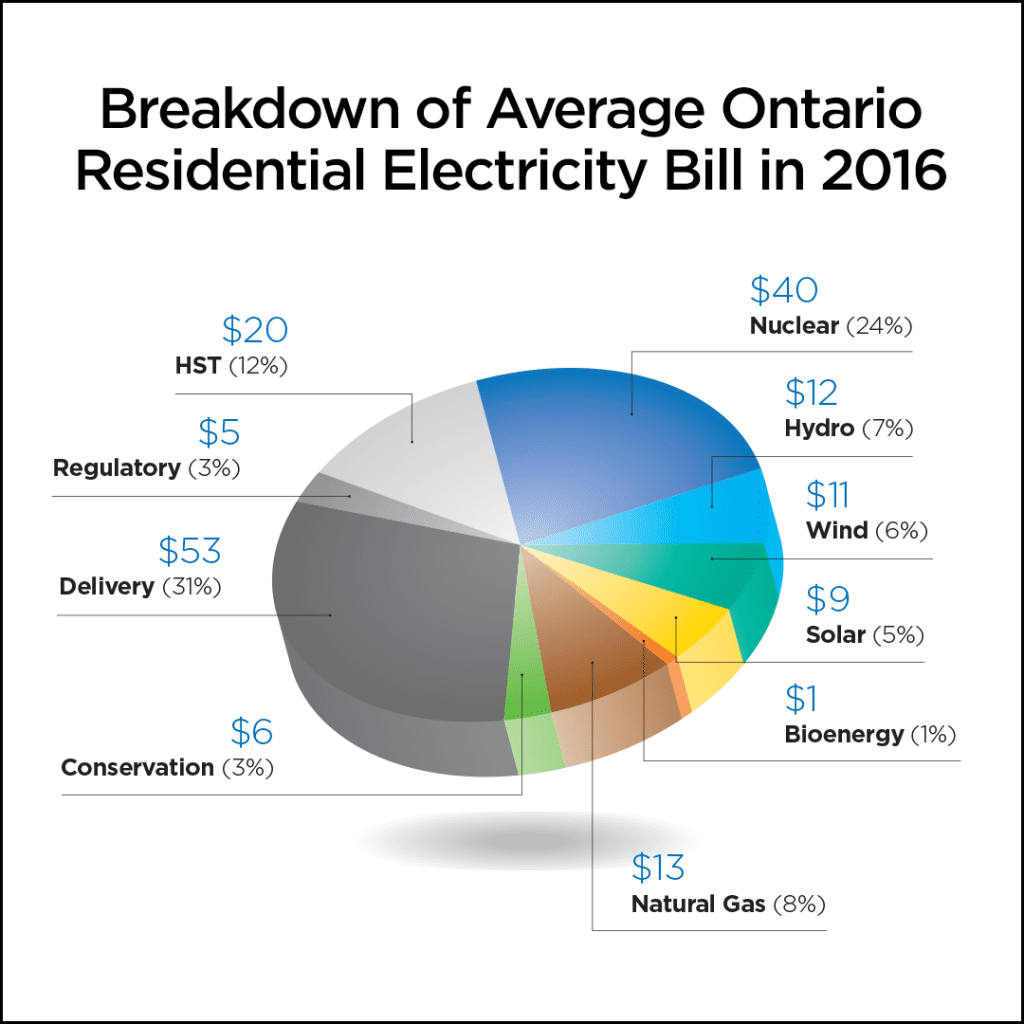Electricity prices in Ontario have risen in recent years, putting the squeeze on some Ontario residents and businesses. There are many reasons for the increase in electricity prices and renewable energy is one of them. However, the role of renewables in driving up electricity bills has been vastly exaggerated.
Wind, solar and biogas are only responsible for a small share of electricity bills, about $20 per month, or 12 per cent of an average Ontario residential electricity bill.
That’s one of the key findings from research we commissioned to shed some light on Ontario’s power system. It’s important to get the facts straight. So, we hired Power Advisory LLC to break down the costs of the average Ontario residential electricity bill, and did some of our own research to dig into some of the arguments frequently made about Ontario’s electricity system, which we summarized in a short backgrounder, released today.
Why have renewables been consistently singled out for blame? Perhaps it’s because wind and solar power are new additions to Ontario’s electricity supply mix. Or because people know that wind and solar power are subsidized as part of an effort to clean up the grid, and to bolster a green power industry in this province. (Something that Ontario largely succeeded at, despite reports to the contrary. See here, and here.)
But renewable energy is being unfairly and inaccurately scapegoated. Yes, wind and solar power installations have grown significantly over the past decade and, today, Ontario has more installed solar generation than anywhere in North America save for California and Arizona. The province is a leader in wind power too. Yet, these sources of power are currently only responsible for a small fraction of what we pay for electricity.
The average Ontario household pays about $11 per month for wind power, and $9 for solar power.
Our report, and Power Advisory’s analysis, also looks at the Global Adjustment charge – a growing component of electricity costs that is also attracting attention of late. News reports often suggest that the Global Adjustment is due to green energy, or energy conservation – but the Global Adjustment includes costs for all forms of generation: solar, wind, hydro, nuclear and gas. Indeed, nuclear power is the largest component of the Global Adjustment. And natural gas is the second largest. Not wind. Not solar.
Our report also looks at how energy prices in Ontario compare to other jurisdictions. Our analysis finds that while electricity prices are high and have risen recently, overall energy costs in Ontario are on par with those of other Canadian provinces. In addition, Ontario’s electricity prices are not the highest in North America and they are very low by European standards.
We also show that Ontario’s coal phase-out is not only the single largest greenhouse gas reduction success story in North America to date, but it also led to dramatic reductions in sulphur dioxides, nitrogen oxides, particulate matter, and mercury emissions – all very serious pollutants with adverse health effects. One of the reasons that Ontario got rid of coal was because of a study that estimated that getting rid of these harmful pollutants would save the province $4.4 billion in annual health and environmental costs – which is 10 times the cost of the premium paid for renewable energy.
Finally, we look at the prices of wind and solar power in the future compared with price forecasts for nuclear power from Ontario Power Generation. Spoiler: Prices for wind and solar are falling, while prices for nukes are projected to rise. Renewables will win the future on cost alone.
The price of electricity is a real issue in Ontario. As a result of rising electricity rates, some residents, especially rural residents with baseboard heaters, now have some hefty bills. The Ontario government needs to do something about that – starting with helping people reduce their energy use.
But don’t scapegoat green energy. When we take a holistic look at what phasing out coal has done and where the costs of wind and solar power are headed, Ontario’s early leadership in renewables is already paying off and has created a base for a clean economy that needs to be built on.
Read the report: Ontario’s Electricity System









